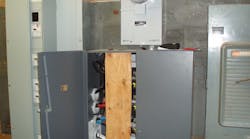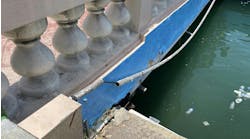How well do you know the Code? Think you can spot violations the original installer either ignored or couldn't identify? Here's your chance to moonlight as an electrical inspector and second-guess someone else's work from the safety of your living room or office. Joe Tedesco, who has a knack for finding shoddy electrical work, did the dirty work and found this mess. Now it's your turn to identify the violation.
Find the Answer
I don’t think so. It’s real plywood! But what is it protecting, and who’s responsible for this installation? Did the electric utility, electrical contractor, or owner install this piece of wood? And how about those parallel conductors? Are they installed correctly? It looks like the open KO is not the big issue here, but there’s still a lot of unanswered questions to be addressed.
In the meantime, check out the requirements of 310.4, which states in part, “Where run in separate raceways or cables, the raceways or cables shall have the same physical characteristics. Where conductors are in separate raceways or cables, the same number of conductors shall be used in each raceway or cable. Conductors of one phase, polarity, neutral, or grounded circuit conductor shall not be required to have the same physical characteristics as those of another phase, polarity, neutral, or grounded circuit conductor to achieve balance.”
”FPN: Differences in inductive reactance and unequal division of current can be minimized by choice of materials, methods of construction, and orientation of conductors.”
We should also take note of 300.20(A), which states in part, “Where conductors carrying alternating current are installed in metal enclosures or metal raceways, they shall be arranged so as to avoid heating the surrounding metal by induction. To accomplish this, all phase conductors and, where used, the grounded conductor and all equipment grounding conductors shall be grouped together.”



